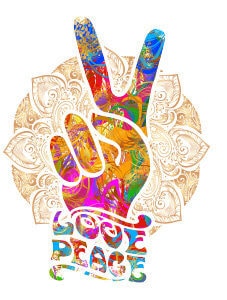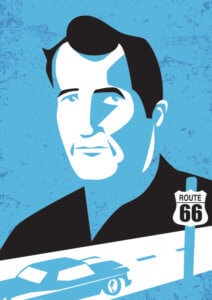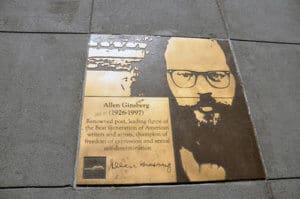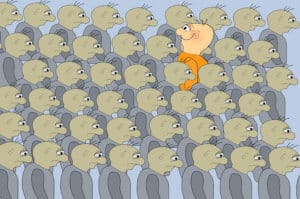Building a house, having a family, chasing prosperity and success was the foundation of the 'American Dream' idea. Seeing this concept of a perfect life emerge, a group of thinkers, writers, and poets set sails on a crusade against the American Dream. Today, we know them as the Beat Generation. Throughout their lives, Allen Ginsberg and Jack Kerouac epitomized the ideas of the Beat Generation. Counterculture movements have a great influence on society, and so did the Beat artists, showing us a different way of living.
What Is the Beat Generation?
Discover the Beat Generation. In the postwar era of the baby boom, the emphasis on family values, economic prosperity, and materialism started to dominate the political and cultural lives of people across the US. However, in the 1950s, a new counterculture started to explore what was considered unnecessary or unrealistic.

Through their literary and cultural works, the Beat Generation rejected the consumerist ideas of the American Dream.
The great artists of this movement devoted their lives to exploring spirituality through Western and Eastern religions, experimented with psychedelic drugs, and promoted sexual liberation and exploration.
Their obscene acts – doing things and living lives considered offensive towards their moral values and standards – pushed the boundaries of American culture, hence having a great influence on generations to come.
These controversial, maybe even foolish actions helped to liberalize US publishing and culture altogether.
The Beat Generation rejected everything that was considered a good life by society. They lived bohemian, hedonistic lives. Members of this movement often had no homes, hitchhiked all across the USA without any money, and indulged in momentary pleasures, such as drugs and alcohol.

Our modern outlook and understanding of non-conformity was largely shaped by the Beat counterculture. Their lives were a manifestation of the values they believed in. Hence, artists like Jack Kerouac and Allen Ginsberg celebrated spontaneous creativity. Through their lifestyle and art, they pushed boundaries and epitomized the Beat Generation.
Later on, in the 1960s, some elements of the Beat Generation culture were incorporated into the larger hippie movement. It’s difficult not to spot similarities between the two countercultures. One could say that the Beat artists were “fathers of the hippies.”
Successively, the poet Allen Ginsberg played a major part in the hippie revolution of the 60s, becoming a bridge figure for the two movements.
Counterculture and an Alternative Lifestyle

Jack Kerouac was one of the greatest motors of the Beat Generation. His novel On the Road became a worldwide bestseller. Kerouac’s literary works were predominantly autobiographical fiction, whose style the author himself called “spontaneous prose.”
On the Road was completed in 1951. The first draft of the novel was written in just about twenty days, following two years of hitchhiking and travelling across the United States and Mexico. Karouac wrote it on one, long sheet of paper, trying to put his memories on paper and transform them into a story.
What we believe in doesn’t matter as long as we don’t act on it. By pursuing his unconventional lifestyle, Jack Kerouac created a manifesto of the Beat Generation’s values.
He led a life of hedonistic heavy drinking, without ever settling down on one job or in one place, always roaming around and searching for something greater than himself. The American Dream provided answers for some of the society’s questions: What constitutes a good life? How should we live to be happy? What gives us meaning?
Kerouac rejected economic materialism, consumerism, and tradition.
His relationships didn’t quite fit in the usual definitions. Love wasn’t something to be taken for granted, and friendship was more unexpected and uncertain than many of us would like it to be.
Kerouac became an underground celebrity, covering topics such as Buddhism, travel, drugs, or Catholic spirituality. What to many would look like an apparent contradiction was what made Kerouac so authentic as a herald of the Beat Generation.
Against the Current

The poet Allen Ginsberg gained a similar status among the movement’s proponents. He began his friendship with Kerouac in the 1940s, and he epitomized the core values of the Beat counterculture throughout his life.
Ginsberg was a harsh critic of bureaucracy, militarism, and sexual repression. Reciting his poems in underground pubs to the sound of jazz and the smell of alcohol, he spread his ideas across the USA.
His views on drugs, hedonistic lifestyle, and Eastern religions broadened the perspective of not only the Americans, but also the entire Western culture.
His poem Howl, pointing to the destructive repercussions of capitalism and conformity, opened people’s eyes on pressing social issues of his times.
Both Kerouac and Ginsberg had more than just big mouths. Apart from speaking loudly and expressing their critique of the American Dream and related concepts, they manifested the values of the Beat Generation through their lifestyle.
Ginsberg is also considered as a social and political activist. His poetry reading during the so-called San Francisco Renaissance-inspired people to tackle taboo and don’t take everything for granted.
In 1956, Howl raised a lot of controversies, as it described heterosexual and homosexual sex. Around the same time, the sodomy laws made homosexualism illegal across the USA. Through his literary work, which also includes autobiographical references, Ginsberg pushed the uncomfortable spots of the then society. As a result, his courage to speak up led to a revolution of thought and liberalization of politics.

Against the current, Ginsberg expressed his anti-war stance in the prospect of the war in Vietnam. He advocated tax resistance as a way of protesting the war in Vietnam, which was also an important case of the hippie movement.
The Beat Generation’s counterculture opposed both societal norms and politics. As we fell into the downward spiral of economic materialism, the movement manifested their opposition to the American Dream. It’s through their lives that they loudly rejected the conformist notions of a “perfect life.”
The Importance of Counterculture
In the words of Jack Kerouac in The Dharma Bums, the 1950s had an underground community of non-conformist Beat artists who chose a different life:
“A world full of rucksack wanderers, Dharma Bums refusing to subscribe to the general demand that they consume production and therefore have to work for the privilege of consuming, all that crap they didn’t really want anyway such as refrigerators, TV sets, cars, and general junk.”
All counterculture movements show us that there’s more than the generally-accepted one and only way to live.
Our lives are more than just random events. Each one of our actions and decisions contributes to our persona, defining what we represent and value in life. The unconventional lifestyles of the Beat Generation – especially Jack Kerouac and Allen Ginsberg – were the embodiment of their beliefs and stances on various social and political issues.
In the times of their literary activity, Ginsberg and Kerouac were seen as fools and madmen by the general public. Today, every individual who opposes the norms and preconceived ideas is also portrayed as a bum or a lunatic.
History taught us that counterculture movements have an immense impact on the world. They aren’t afraid to question what is certain and reject the conformist ideas. Looking at the example of the Beat Generation, we should change our outlook on young artists, controversial figures, and underground personas.
Nowadays, people who reject what is known are likely to shape our society in the future. No system is perfect, and this fight between two opposing ideas is what drives societal change. Hitchhikers, painters, and poets – they all lead to the progress in thought and a revolution of ideas. Paraphrasing Ginsberg, they’re all fools – and that’s exactly what they should do.
Photos: Shutterstock / Photomontage: Martina Advaney
Read more here.
Main Takeaways from Harari’s “21 Lessons for the 21st Century”
Support us!
All your donations will be used to pay the magazine’s journalists and to support the ongoing costs of maintaining the site.
Share this post
Interested in co-operating with us?
We are open to co-operation from writers and businesses alike. You can reach us on our email at [email protected]/[email protected] and we will get back to you as quick as we can.










